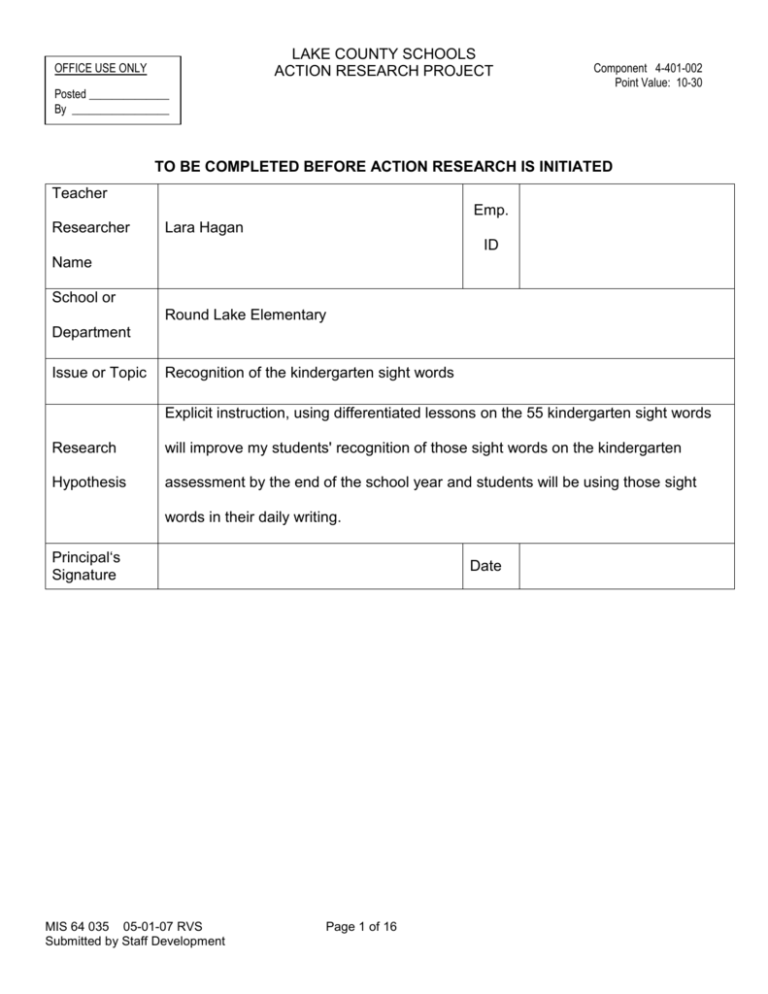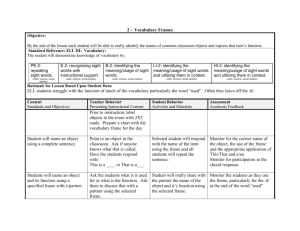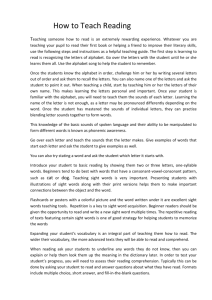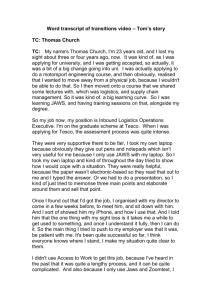Sight Word Recognition
advertisement

LAKE COUNTY SCHOOLS ACTION RESEARCH PROJECT OFFICE USE ONLY Posted ______________ By _________________ Component 4-401-002 Point Value: 10-30 TO BE COMPLETED BEFORE ACTION RESEARCH IS INITIATED Teacher Emp. Researcher Lara Hagan ID Name School or Round Lake Elementary Department Issue or Topic Recognition of the kindergarten sight words Explicit instruction, using differentiated lessons on the 55 kindergarten sight words Research will improve my students' recognition of those sight words on the kindergarten Hypothesis assessment by the end of the school year and students will be using those sight words in their daily writing. Principal‘s Signature MIS 64 035 05-01-07 RVS Submitted by Staff Development Date Page 1 of 16 TO BE COMPLETED AT CONCLUSION OF ACTION RESEARCH RESEARCH PROCESS 1. What student data formed the baseline? Lake County Kindergarten Assessment Form 2. What research resources, i.e., books, documents, were studied? Harcourt web-site, Systematic Sight Word Instruction Curriculum, teacher collaboration 3. What student demographic groups were used and how were they selected? All 19 students were given the same instruction since there was such a severe need. Extra assistance was given to the ESOL and retained populations. 4. What was the timeline for the study? September 12, 2009- April 20, 2010 Approved Disapproved Comments Principal assigns 10-30 points Principal’s Signature Director of Staff Development Signature MIS 64 035 05-01-07 RVS Submitted by Staff Development Date Date Acknowledged Page 2 of 16 LAKE COUNTY SCHOOLS ACTION RESEARCH PROJECT - SHARING THE RESULTS [Complete online and email to Haskinsbj@lake.k12.fl.us] Title of Action Research Project Sight Word Recognition Name of Teacher Researcher Lara Hagan Name of School Round Lake Elementary MIS 64 035 05-01-07 RVS Submitted by Staff Development Page 3 of 16 Grade Level Kindergarten Answer the following questions in your abstract. DO NOT USE teacher or student names. 1. Classroom Problem: The problem is that the students are not meeting the kindergarten requirements in reading sight words and using sight words in daily work. In my class, all students entered kindergarten knowing between 0-9 sight words (out of 55 required sight words), which would score them on an unsatisfactory level on the report card. 13/19 students were only able to read 0-2 words; with the letters "I' and "a" being two of the tested sight words. After the initial sight word recognition test, I determined that the major weakness was due to lack of exposure to the kindergarten sight words before entering kindergarten. In order to teach my students, I must first educate the parents about the importance of knowing sight words. I will inform parents of this research project through conferences and 9 week letters. I will teach the students the sight words through explicit instruction using a variety of learning style methods. I will do progress monitoring on a continual basis to provide data for my research. My goal is for all of my students to be able to recognize more sight words and use them in their daily writings. 2. Research Process: My first step of this action research process was to give the initial sight word assessment test to all of my students to get my first data figures. I then analyzed the data and started focusing on making a sight word curriculum. I consulted with other colleagues to share information with them and to obtain their worksheets and web-sites they went to for information regarding sight words. I did internet searches on sight word instruction and began making small group games, worksheets, flashcards, and puzzles on the 55 kindergarten sight words. I sorted through worksheets and planned out the year's curriculum as it would progress. I scanned in the worksheets to the computer so that I could save my files and add to them later with new worksheets. Some worksheets were not kindergarten appropriate so I had to change them to fit my students. I also held parent conferences and gave the parents a list of all of the sight words MIS 64 035 05-01-07 RVS Submitted by Staff Development Page 4 of 16 that I would be teaching. I included these lists in homework and at the beginning of each nine week period. I also gave the parents flashcards they could use in order to review the sight words at home. I frequently assessed students both informally using oral tests (like flashcards in whole group settings) and formally tested them 1-on-1 to get the next set of data points for my research. I learned that through the assessments, I needed to re-teach some of the sight words and give some sight words more direct instruction time than others. (This was evident with the –wh sight words like when, where, who, and what.) I continued collecting data and teaching and re-teaching throughout the year and came up with my results. 3. Collection and Analysis: The following 2 illustrations show the data collected over the period of time between Sept, 14, 2009 – April 20, 2010. The first graph shows that the data toward the beginning of the year is clustered around the numbers 0-9, which represents the number of sight words read at that time. For example, if we analyze the first testing date, Sept. 14, 2009, dark blue graph lines, we are able to see that 1 student read 0 words, 6 students read 1 word, 6 students read 2 words, 2 students read 3 words, 1 student read 4 words, 1 student read 8 words, and 1 student read 9 words; totalling 18 students tested. As the school year progresses, the data lines move toward the higher numbers as the students are able to read more sight words. The progression of the data lines move from dark blue, burgandy, green, purple, and light blue. The light blue lines are the last testing data and shows that 1 student read 19 words, 2 students read 22 words, 1 student read 33 words, 1 student read 35 words, 1 student read 39 words, 3 students read 47 words, 2 students read 48 words, 3 students read 50 words, 3 students read 51 words, 1 student read 53 words and 1 student read 55 words; totalling the 19 students tested at the end of the school year. This visual shows that all students are ending the year toward the middle of the graph or at the end of the chart (which means mastery of the skill). MIS 64 035 05-01-07 RVS Submitted by Staff Development Page 5 of 16 MIS 64 035 05-01-07 RVS Submitted by Staff Development Page 6 of 16 race test dates & # of sight words read gender "student name" Sight Word Recognition Assessment Data 2009-2010 a m w 4 8 34 50 55 b f multi 2 5 17 38 53 c f w 1 2 21 38 51 d f w 9 11 29 38 51 e f w 2 8 19 38 51 f Hisp. 0 1 13 35 50 g m w 2 8 31 44 50 h m w 3 8 34 39 50 i f w 2 4 22 33 48 j m w entered in mid. February 37 48 k m w 2 5 18 33 47 l m w 2 4 22 34 47 m m w 1 3 21 42 47 f black 8 10 23 30 39 o f w 3 6 14 27 35 p m w 1 2 12 29 33 m Hisp. 1 1 3 15 22 m w s ESOL- 2nd year in K, in RtI for behavior m Creole 1 1 5 14 19 t in RtI for behavior m w 1 5 44 53 withdrew f n q r ESOL 2nd year in K, in RtI for academics and behavior, takes ADHD medication ESOL takes ADHD medication MIS 64 035 05-01-07 RVS Submitted by Staff Development 9/14/2009 10/15/2009 1/7/2010 3/10/2010 4/20/2010 entered in mid. April Page 7 of 16 22 In this table, I am showing the different sub-goups within my classroom. I listed students by gender and race and also included more comments that I thought needed to be taken into consideration when the data was being reviewed. For instance, I made notes of the students who take ADHD medication, who are retained, and in the RtI process because all of these factors would explain why they may have not made the gains as a regular education student. I organized this chart with student "a" at the top because they were able to read the most sight words on the last testing date. I ended with student "s" because this student had the lowest number of sight words read at the last testing date. I included student "t" in the data because this student made great gains in my class through the direct instruction of the sight words and I thought the data would be beneficial to see how the teaching made an impact on the recognition of the sight words. In summary, 100% of students in my kindergarten class made gains in the area of sight word recognition, no matter whether they were boys or girls, what race they are, previously retained, ESOL, late to enroll, or in the RtI process for academic/behavioral concerns. All students progressed. My greatest result was in student "f" who spoke no English when she enrolled in school, had never been in a school setting before and went from knowing 0 sight words to being able to recognize 50 sight words at the end of the year. This shows that she was emersed in learning and this process works. The following pages show student work samples and the use of sight words in their daily writings. These writings were taken from the ESOL, retained, and higher level achieveing students to show that all students are writing using the sight words taught to them. (The sight words taught have been circled.) MIS 64 035 05-01-07 RVS Submitted by Staff Development Page 8 of 16 MIS 64 035 05-01-07 RVS Submitted by Staff Development Page 9 of 16 MIS 64 035 05-01-07 RVS Submitted by Staff Development Page 10 of 16 MIS 64 035 05-01-07 RVS Submitted by Staff Development Page 11 of 16 MIS 64 035 05-01-07 RVS Submitted by Staff Development Page 12 of 16 MIS 64 035 05-01-07 RVS Submitted by Staff Development Page 13 of 16 MIS 64 035 05-01-07 RVS Submitted by Staff Development Page 14 of 16 4. Action and Sharing the Research Project: I taught and modeled sight words in direct instruction and provided guided practice with sight word games, technology, and independent practice. I used teacher made activities and worksheets to enhance my sight word curriculum. I also collaborated with other teachers to share ideas on the teaching of the sight words. I encouraged my professional learning community of teachers to create their own sight word files. What I found truly beneficial was that other teachers were enthusiastic about my action project and supported me through this experience, which made a great learning environment for the teachers as well as the students. 5. Professional Reflection: I learned that this action research project was beneficial because of the frequency and intensity I used in the teaching of the kindergarten sight words. I have created a file of sight word games and activities that I will use from year to year in which I can add to and make better. This action research project allowed me to focus on an area of my teaching that I felt I needed to be enhanced; and I feel that was achieved. I feel that I am a better teacher because of this project and that my students have become better lifelong learners because of the base foundation I gave them with the sight words. I plan on continuing this project next year; but to make it better, I would make or buy some new sight word games to give more variety to my materials, find some sight word songs and incorporate them into my core sight word curriculum for the auditory learners, and I would like to purchase more sight word student readers so that each child could have more practice at home reading books using the sight words they have been taught. MIS 64 035 05-01-07 RVS Submitted by Staff Development Page 15 of 16 ABSTRACT: All students in my kindergarten class participated in action research from September 2009 to April 2010 which focused on sight word instruction because they had little recognition of the 55 basic sight words. Would an intensive sight word curriculum improve recognition of the sight words by the end of the school year? Students received instruction during whole group, small groups, and individual settings using games, manipulatives, and worksheets. Collected and analyzed data proves that 100% of my students made growth in the number of sight words recognized. The next step is to add more sight words and continually improve the curriculum. Source: A Guide to Becoming an Action Research – Department of Education MIS 64 035 05-01-07 RVS Submitted by Staff Development Page 16 of 16



